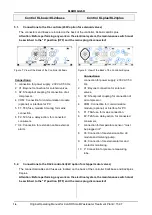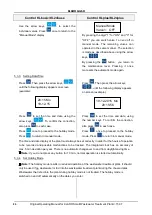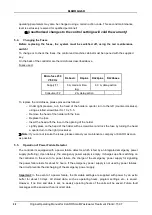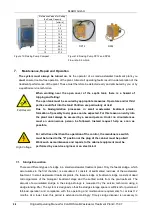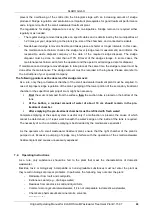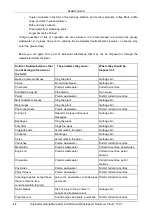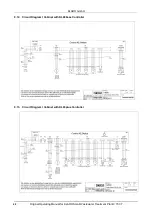
KLARO GmbH
30
Original Operating Manual for KLARO Small Wastewater Treatment Plant V.15.07
-
Coarse materials in the form of food scraps, plastics, and sanitary products, coffee filters, bottle
caps, and other household items,
-
Milk and dairy products,
-
Drain water from swimming pools,
-
Larger amounts of blood.
If large quantities of fats or vegetable oils are produced, it is recommended to pre-clean the greasy
wastewater in a grease trap prior to entering the wastewater treatment plant (caution: no faeces may
enter the grease trap!).
Below you will again find a list of individual substances that may not be disposed of through the
wastewater treatment plant:
Solid or liquid substances that
do not belong in the drain or
the toilet:
The problems they cause:
Where they should be
disposed of:
Make-up removal tissues
Clog the plant
Garbage bin
Ashes
Do not decompose
Garbage bin
Chemicals
Poisons wastewater
Collection centres
Disinfection agents
Kill bacteria
Do not use
Paints
Poison wastewater
District collection centres
Moist bathroom tissues
Clog the plant
Garbage bin
Moist wipes
Clog the plant
Garbage bin
Photo chemicals
Poison wastewater
District collection centres
Frying oil
Deposits in pipes and causes
blockages
Garbage bin
Bandages
Clog the pipes
Garbage bin
Kitty litter
Clogs the pipes
Garbage bin
Cigarette butts
accumulate in the plant
Garbage bin
Condoms
Blockages
Garbage bin
Corks
accumulate in the plant
Garbage bin
Varnishes
Poison wastewater
District collection centres
Medication
Poisons wastewater
Collection centres, pharmacies
Engine oil
Poisons wastewater
Collection centres, petrol
stations
Oily waste
Poisons wastewater
Collection centres, petrol
stations
Pesticides
Poison wastewater
District collection centres
Paint thinners
Poison wastewater
District collection centres
Cleaning supplies, except those
that are chlorine-free
(environmentally friendly)
poison the wastewater, corrode pipes
and seals
District collection centres
Razor blades
Risk of injury to the workers in
sewers and treatment plant
Garbage bin
Pipe cleaners
Corrode pipes and seals, poison the District collection centres
KLARO GmbH
Original Operating Manual for KLARO Small Wastewater Treatment Plant V.15.07
31
Solid or liquid substances that
do not belong in the drain or
the toilet:
The problems they cause:
Where they should be
disposed of:
wastewater
Insecticides
Poison wastewater
District collection centres
Panty liners
Cause blockages, non-
decomposable plastic liners spoil
waters
Garbage bin
Cooking oil
Causes deposits and pipe blockages District collection centres
Leftover food
Causes blockages, attracts rats
Garbage bin
Wallpaper glue
Causes blockages
District collection centres
Textiles (e.g., nylon stockings,
cleaning cloths, handkerchiefs,
etc.)
Clog pipes, can disable a pumping
station
Clothing collection
Paint thinner
Poisons the wastewater
District collection centres
Bird sand, cat litter
Causes deposits and pipe blockages Garbage bin
Cotton pads
Clog the plant
Garbage bin
Cotton swabs
Clog the plant
Garbage bin
Toilet blocks
Poison wastewater
Do not use
Diapers
Clog pipes
Garbage bin
Cement water
Settles, creates concrete deposits
Hire specialist company
For general questions on this issue, you are always invited to contact KLARO GmbH in Bayreuth.
8.
Fault Messages and Troubleshooting
Technical malfunctions of the plant operation (failure of a unit) are indicated both, visually and
acoustically. The acoustic warning signal of the controller can be stopped by pressing
. The optical
fault indicator is acknowledged only after pressing
again.
In the event of failure of the power supply, an integrated mains-independent power failure signalling
device gives an audible warning alternately with an optical indicator. This case cannot be acknowledged.
High voltage!
When performing work on the machine cabinet that goes beyond the
operation of the controller, the cabinet must be disconnected from the mains
voltage.
KLARO GmbH
2
Original Operating Manual for KLARO Small Wastewater Treatment Plant V.15.07
IMPORTANT:
•
This Operating Manual contains information about the plant, from installation
to maintenance, and must therefore be read before commissioning of the
plant!
•
All safety instructions must be observed!
•
The Operating Manual must be kept readily available during the operation of
the plant!
Plant Specifications
For any questions in the course of the operation of the plant, the specifications of your plant should
be noted as follows. With the help of this information, our staff will be able to help you more quickly
in the event of a malfunction. The specifications can be found on the nameplate, which is located
on the outside of the cabinet door for indoor cabinets, and inside the cabinet for outdoor cabinets.
Small Wastewater Treatment
Plant
PT
Sludge storage
Buffer
SB-Reactor
Approval No.:
Process class:
Certified:
Cabinet:
Controller:
Compressor:
Denomination:
Serial No.:
Article No.:
Additional module:
Article No.:
El. Connected load:
KLARO GmbH
2
Original Operating Manual for KLARO Small Wastewater Treatment Plant V.15.07
IMPORTANT:
•
This Operating Manual contains information about the plant, from installation
to maintenance, and must therefore be read before commissioning of the
plant!
•
All safety instructions must be observed!
•
The Operating Manual must be kept readily available during the operation of
the plant!
Plant Specifications
For any questions in the course of the operation of the plant, the specifications of your plant should
be noted as follows. With the help of this information, our staff will be able to help you more quickly
in the event of a malfunction. The specifications can be found on the nameplate, which is located
on the outside of the cabinet door for indoor cabinets, and inside the cabinet for outdoor cabinets.
Small Wastewater Treatment
Plant
PT
Sludge storage
Buffer
SB-Reactor
Approval No.:
Process class:
Certified:
Cabinet:
Controller:
Compressor:
Denomination:
Serial No.:
Article No.:
Additional module:
Article No.:
El. Connected load:
30

